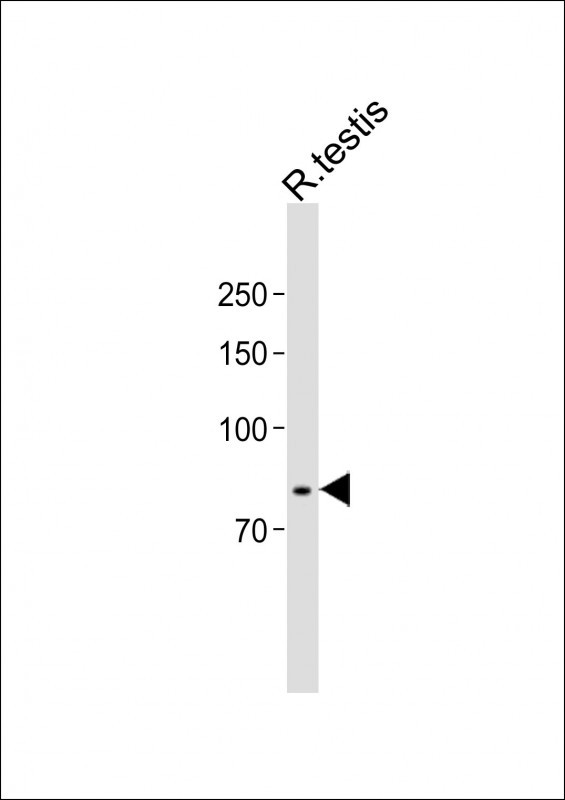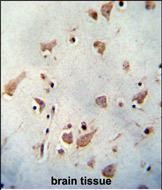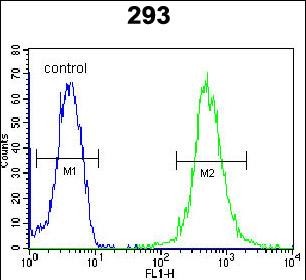WDR48 Antibody (C-term)
Affinity Purified Rabbit Polyclonal Antibody (Pab)
- 产品详情
- 实验流程
- 背景知识
Application
| WB, IHC-P, FC, E |
|---|---|
| Primary Accession | Q8TAF3 |
| Other Accession | Q4R2Z6, Q32PG3, NP_065890.1 |
| Reactivity | Rat |
| Predicted | Bovine, Monkey |
| Host | Rabbit |
| Clonality | Polyclonal |
| Isotype | Rabbit IgG |
| Calculated MW | 76210 Da |
| Antigen Region | 603-630 aa |
| Gene ID | 57599 |
|---|---|
| Other Names | WD repeat-containing protein 48, USP1-associated factor 1, WD repeat endosomal protein, p80, WDR48, KIAA1449, UAF1 |
| Target/Specificity | This WDR48 antibody is generated from rabbits immunized with a KLH conjugated synthetic peptide between 603-630 amino acids from the C-terminal region of human WDR48. |
| Dilution | WB~~1:500 IHC-P~~1:100~500 FC~~1:10~50 E~~Use at an assay dependent concentration. |
| Format | Purified polyclonal antibody supplied in PBS with 0.05% (V/V) Proclin 300. This antibody is purified through a protein A column, followed by peptide affinity purification. |
| Storage | Maintain refrigerated at 2-8°C for up to 2 weeks. For long term storage store at -20°C in small aliquots to prevent freeze-thaw cycles. |
| Precautions | WDR48 Antibody (C-term) is for research use only and not for use in diagnostic or therapeutic procedures. |
| Name | WDR48 {ECO:0000303|PubMed:24145035, ECO:0000312|HGNC:HGNC:30914} |
|---|---|
| Function | Regulator of deubiquitinating complexes, which acts as a strong activator of USP1, USP12 and USP46 (PubMed:18082604, PubMed:19075014, PubMed:26388029, PubMed:31253762). Enhances the USP1- mediated deubiquitination of FANCD2; USP1 being almost inactive by itself (PubMed:18082604, PubMed:31253762). Activates deubiquitination by increasing the catalytic turnover without increasing the affinity of deubiquitinating enzymes for the substrate (PubMed:19075014, PubMed:27373336). Also activates deubiquitinating activity of complexes containing USP12 (PubMed:19075014, PubMed:27373336, PubMed:27650958). In complex with USP12, acts as a potential tumor suppressor by positively regulating PHLPP1 stability (PubMed:24145035). Docks at the distal end of the USP12 fingers domain and induces a cascade of structural changes leading to the activation of the enzyme (PubMed:27373336, PubMed:27650958). Together with RAD51AP1, promotes DNA repair by stimulating RAD51-mediated homologous recombination (PubMed:27239033, PubMed:27463890, PubMed:32350107). Binds single- stranded DNA (ssDNA) and double-stranded DNA (dsDNA) (PubMed:27239033, PubMed:31253762, PubMed:32350107). DNA-binding is required both for USP1-mediated deubiquitination of FANCD2 and stimulation of RAD51- mediated homologous recombination: both WDR48/UAF1 and RAD51AP1 have coordinated role in DNA-binding during these processes (PubMed:31253762, PubMed:32350107). Together with ATAD5 and by regulating USP1 activity, has a role in PCNA-mediated translesion synthesis (TLS) by deubiquitinating monoubiquitinated PCNA (PubMed:20147293). Together with ATAD5, has a role in recruiting RAD51 to stalled forks during replication stress (PubMed:31844045). |
| Cellular Location | Nucleus. Cytoplasm. Lysosome. Late endosome. Note=Mainly in cytoplasmic compartments (PubMed:12196293, PubMed:18032488). In case of infection by papillomavirus HPV11, translocates to the nucleus via its interaction with papillomavirus HPV11 (PubMed:18032488) |
| Tissue Location | Ubiquitous.. |
For Research Use Only. Not For Use In Diagnostic Procedures.
Provided below are standard protocols that you may find useful for product applications.
BACKGROUND
Regulator of deubiquitinating complexes. Acts as a strong activator of USP1 by enhancing the USP1-mediated deubiquitination of FANCD2; USP1 being almost inactive by itself. Also activates deubiquitinating activity of complexes containing USP12 and USP46, respectively. Activates deubiquitination by increasing the catalytic turnover without increasing the affinity of deubiquitinating enzymes for the substrate. In case of infection by Herpesvirus saimiri, may play a role in vesicular transport or membrane fusion events necessary for transport to lysosomes. Induces lysosomal vesicle formation via interaction with Herpesvirus saimiri tyrosine kinase-interacting protein (TIP). Subsequently, TIP recruits tyrosine-protein kinase LCK, resulting in down-regulation of T-cell antigen receptor TCR. May play a role in generation of enlarged endosomal vesicles via interaction with TIP. In case of infection by papillomavirus HPV11, promotes the maintenance of the viral genome via its interaction with HPV11 helicase E1.
REFERENCES
Kee, Y., et al. J. Biol. Chem. 285(15):11252-11257(2010)
Cohn, M.A., et al. J. Biol. Chem. 284(8):5343-5351(2009)
Cote-Martin, A., et al. J. Virol. 82(3):1271-1283(2008)
Cohn, M.A., et al. Mol. Cell 28(5):786-797(2007)
Park, J., et al. J. Virol. 77(16):9041-9051(2003)
终于等到您。ABCEPTA(百远生物)抗体产品。
点击下方“我要评价 ”按钮提交您的反馈信息,您的反馈和评价是我们最宝贵的财富之一,
我们将在1-3个工作日内处理您的反馈信息。
如有疑问,联系:0512-88856768 tech-china@abcepta.com.























 癌症的基本特征包括细胞增殖、血管生成、迁移、凋亡逃避机制和细胞永生等。找到癌症发生过程中这些通路的关键标记物和对应的抗体用于检测至关重要。
癌症的基本特征包括细胞增殖、血管生成、迁移、凋亡逃避机制和细胞永生等。找到癌症发生过程中这些通路的关键标记物和对应的抗体用于检测至关重要。 为您推荐一个泛素化位点预测神器——泛素化分析工具,可以为您的蛋白的泛素化位点作出预测和评分。
为您推荐一个泛素化位点预测神器——泛素化分析工具,可以为您的蛋白的泛素化位点作出预测和评分。 细胞自噬受体图形绘图工具为你的蛋白的细胞受体结合位点作出预测和评分,识别结合到自噬通路中的蛋白是非常重要的,便于让我们理解自噬在正常生理、病理过程中的作用,如发育、细胞分化、神经退化性疾病、压力条件下、感染和癌症。
细胞自噬受体图形绘图工具为你的蛋白的细胞受体结合位点作出预测和评分,识别结合到自噬通路中的蛋白是非常重要的,便于让我们理解自噬在正常生理、病理过程中的作用,如发育、细胞分化、神经退化性疾病、压力条件下、感染和癌症。








